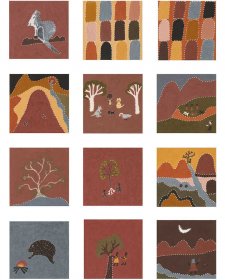- About us
- Support the Gallery
- Venue hire
- Publications
- Research library
- Organisation chart
- Employment
- Contact us
- Make a booking
- Onsite programs
- Online programs
- School visit information
- Learning resources
- Little Darlings
- Professional learning
Ngalim-Ngalimbooroo Ngagenybe (From My Women) by Shirley Purdie, senior Gija artist, 2018. This work uses natural ochre and pigments on canvas.
This expansive work is composed of 36 individual canvas panels, each 45 cm square, arranged in a rectangular grid of 4 rows of 9, forming a work that is 5 and a half metres wide and 2 and a half metres tall. It is a non-representational self-portrait informed by Aboriginal ways of seeing and understanding the world. The panels show traditional Gija stories, personal stories and Ngarranggarni (the Gija dreaming).
The ochres used to make this work create a palette of warm earthy colour that is consistent across the panels: rust reds; deep warm browns; earthy oranges; mustard and sandy yellows; olive greens; grey blues; and dusty pinks, along with black and white. The art style is simplified, the forms flattened, and the ochre gives the work a subtle texture, with the appearance of fine sandpaper. The points of view vary from close-up to far away, and from front-on to bird’s-eye view. The subjects of each panel are lined with fine white dot-work.
The top row of paintings show stories of kinship, introducing significant women from both sides of Shirley Purdie’s family, with most panels showing individual native animals. From left to right, these panels show: a snake; a bush turkey; a black crow; a rock wallaby; 2 panels of mound-like shapes; a turtle; an emu; and a brolga. The mound-like shapes in the centre panels resemble termite mounds, or doorways with rounded tops. They’re arranged in both panels in a grid, 3 rows with 4 mounds in each row, and each mound uses a different colour taken from the work’s palette.
The second row of paintings depicts specific places, experiences and activities. From left to right they are: a river flowing between hills; trees on a hillside; a single tall tree; a river flowing down a hill; a person sitting between 2 trees alongside a dog, a cat, a kangaroo and a bird; 3 people with 3 dogs across a valley from a white man; a woman next to a washing line in front of a homestead; 6 people gathered together in a circle; and 2 people and a dog in the back of a ute.
The third row of paintings come from Ngarranggarni, the Gija dreaming. From left to right: a landscape with hills in the background; 6 animals on a sandy background including 3 birds, as well as a grub, a cocoon and a moth; a more abstract piece of organic shapes; a leafy tree by the water; 2 people by a tree that shows its roots; a river flowing between hills to a person next to a tree; a reptile beneath an arc of many colours resembling a rainbow; a tall tree alone on a rock; and an abstract piece of earthy colours resembling the paths of rivers from above.
The fourth row of paintings features stories from Ngarranggarni, memories, relationships, and country. From left to right: a lone tree; a landscape scene showing a river, with hills in the background and 3 animals taking refuge in a cave with a person outside it; a scene from above a river flowing through a circular body of water, each side of the circle flanked by sandy patches on its banks and a tree; an echidna next to a small log fire; 2 people standing at a tree; a person standing by a river under a crescent moon over hills; 6 people in traditional dress gathered around a fire; a river flowing past hills under a dark sky; and a single leafy tree standing on a mound of earth.
Audio description written by Marina Neilson and voiced by Krysia Kitch
Shirley Purdie (b. 1947) is a senior Gija artist at the Warmun Art Centre who has been painting for more than twenty years. Purdie has lived on her Country, Western Australia's East Kimberley, all her life. Inspired by senior Warmun artists, including her late mother, Madigan Thomas, she began to paint sites and narratives associated with her Country in the early 1990s. A prominent leader in the Warmun community, her cultural knowledge and artistic skill allow her to pass on Gija stories and language to the younger generations.
In 2018, Purdie was selected to contribute to the National Portrait Gallery's 20th anniversary exhibition, So Fine: Contemporary Women Artists Make Australian History. Composed of 36 paintings, Purdie's self-portrait Ngalim-Ngalimbooroo Ngaginbe is an eloquent and stunning visualisation of personal history, identity and connection to Country. 'It's good to learn from old people. They keep saying when you paint you can remember that Country, just like to take a photo … When the old people die, young people can read the stories from the paintings. They can learn from the paintings and maybe they want to start painting too.' Using richly textured ochres collected on her Country, Purdie's work is a kaleidoscope of traditional Gija stories and Ngarranggarni passed down to her.
Purchased 2019
© Shirley Purdie/Copyright Agency, 2024
Shirley Purdie (age 71 in 2018)



On one level The Companion talks about the most famous and frontline Australians, but on another it tells us about ourselves.



Joanna Gilmour reflects on 25 years of collecting at the National Portrait Gallery.



27 May 2020
Emily Casey takes in Shirley Purdie’s remarkable self-portrait, Ngalim-Ngalimbooroo Ngagenybe.